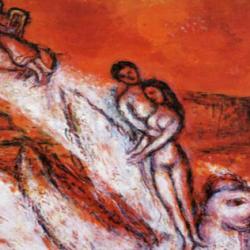When I taught literature, I told students that poetry is a “concentrated excess of language.” Song of Songs 2:16a is poetry of poetry.
Woodenly translated, it says, “My beloved to me, and I to him.” The overlapping structures in that deceptively simple statement are wondrous. On the one hand, it is a parallel structure, repeating the prepositional phrase with “to”:
A. My beloved
B. to me
A’. and I
B’. to him
On the other hand, it is a chiasm:
A. My beloved (that is, the man)
B. to me
B’. I
A’. to him.
In the Hebrew, the concentration is even more evident. The sentence is only four Hebrew words: dodi li v’ani lo . The music is complex and lovely. The line divides into two three-syllable sections: dodi li / v’ani lo . Each of the first three words ends with a hireq-yod, usually pronounced with a long “e” sound: dodee lee va’anee. The first half-line ends with the upward “ee” sound, while the second half-line ends with a lowering “o” that suggests closure. There’s a rough aural chiasm going too. Look at the vowels: 0-i-i-a-i-o. The concluding ” lo ” echoes the opening ” do ,” and in the center are three rhyming syllables – di , li , ni . From the opening “o,” he line rises through a series of “ees” and then quietly slides to the concluding “o.”
All that, and we’ve not even begun to look at the meaning of the words.











